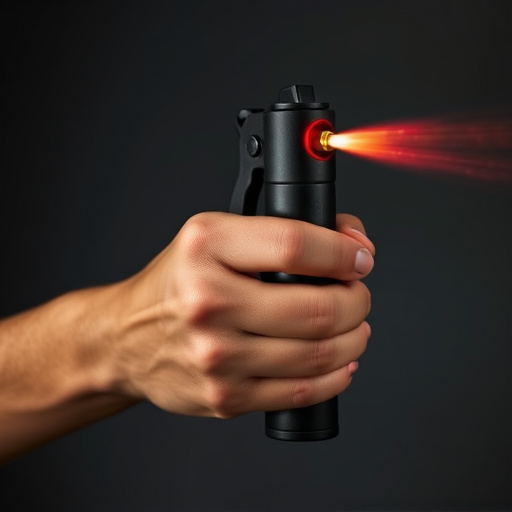Tactical pepper spray, powered by capsaicin, offers non-lethal self-defense in various scenarios through diverse deployment methods including handheld devices, gun-mounted units, and integrated clothing. Effective for incapacitating attackers temporarily, these sprays come in different strengths and patterns for specific needs, from close-quarters combat to outdoor situations. Proper holster selection, understanding spray techniques, and adherence to legal guidelines are crucial for maximizing its effectiveness as a last resort defense tool.
Personal security is a top concern in today’s unpredictable world. Among various self-defense tools, tactical pepper spray stands out as a powerful and effective deterrent. This comprehensive guide delves into the science, deployment methods, and legal aspects of tactical pepper spray, equipping you with essential knowledge for maximizing its impact. From understanding its mechanism to choosing the right product and navigating legal considerations, we explore strategic deployment techniques to ensure your safety effectively.
- Understanding Tactical Pepper Spray: A Powerful Self-Defense Tool
- The Science Behind Pepper Spray: How It Works and Its Effectiveness
- Choosing the Right Pepper Spray for Your Needs
- Strategic Deployment Techniques for Maximum Impact
- Legal Considerations and Responsible Use of Pepper Spray
Understanding Tactical Pepper Spray: A Powerful Self-Defense Tool
Tactical pepper spray is a powerful self-defense tool that has gained significant popularity among individuals seeking effective personal security measures. Unlike traditional pepper spray, tactical varieties are designed with specific deployment methods in mind, making them more versatile and efficient for various scenarios. These sprays utilize capsaicin, the active ingredient responsible for the burning sensation associated with chili peppers, to incapacitate attackers temporarily.
The deployment methods for tactical pepper spray include hand-held devices, gun-mounted units, and even specialized equipment integrated into clothing or gear. Hand-held options offer precision and control, allowing users to aim directly at the attacker’s face or eyes. Gun-mounted sprays are popular among law enforcement and military personnel, providing a quick and reliable defense while in active duty. Additionally, innovative designs enable discreet integration into everyday items like keys or even personal protective equipment, ensuring individuals are prepared for unexpected situations without compromising mobility or comfort.
The Science Behind Pepper Spray: How It Works and Its Effectiveness
The science behind pepper spray, also known as capsaicin spray, is a powerful defensive tool that has revolutionized personal security. This chemical compound, derived from chili peppers, is a highly effective irritant that specifically targets the human senses, particularly the eyes and respiratory system. When deployed, tactical pepper spray creates a temporary yet intense disruption by binding to pain receptors, leading to a burning sensation and reduced visibility.
The effectiveness of pepper spray lies in its ability to provide a non-lethal yet powerful deterrent. The spray’s range and deployment methods, such as aerosol or liquid formulations, enable users to maintain a safe distance from potential threats while neutralizing an attacker momentarily. This strategic advantage is particularly valuable in self-defense scenarios, law enforcement operations, and even for individuals working in high-risk environments, ensuring their safety and peace of mind.
Choosing the Right Pepper Spray for Your Needs
When considering tactical pepper spray, understanding your specific needs and deployment methods is crucial. Different situations call for varying strengths and application techniques. For close-quarters combat, a powerful formula with a short range might be ideal, while longer-range options are better suited for outdoor scenarios or when facing multiple aggressors. The method of deployment also plays a significant role in effectiveness; consider the type of holster or carrier you’ll use, whether it’s for your belt, pocket, or bag, and select a spray that complements this.
Furthermore, familiarizing yourself with different spray patterns—like stream, fog, or burst—ensures you can deploy the spray optimally during an encounter. Some products offer advanced features like easy-to-use one-hand triggers or UV markers to track usage, enhancing both safety and convenience. Always choose a brand that provides clear instructions and adheres to legal regulations, ensuring your rights as a self-defense advocate.
Strategic Deployment Techniques for Maximum Impact
In personal security, strategic deployment techniques for tactical pepper spray are key to maximizing its impact. One effective method is the proactive approach, where individuals carry and utilize the spray in potential threat scenarios, such as dark alleys or isolated areas known for crime activity. This tactic allows for swift intervention and deterrence before a situation escalates.
Another powerful technique is area denial, employing pepper spray to disable access to specific locations. This involves strategic placement of the spray in public spaces, transportation hubs, or entry points to buildings. By making these areas temporarily inaccessible, it serves as a strong deterrent for potential criminals, enhancing overall security. The key to successful deployment lies in combining these methods with awareness and training, ensuring individuals know when and how to use tactical pepper spray effectively.
Legal Considerations and Responsible Use of Pepper Spray
The legal landscape surrounding pepper spray, or tactical pepper spray deployment methods, varies significantly across jurisdictions. It’s crucial for individuals to understand local laws and regulations before acquiring and using such products. Some regions have strict restrictions on who can possess and deploy pepper spray, as well as where and how it can be used. Non-compliance can result in severe penalties, including fines and imprisonment.
Responsible use is equally important. Pepper spray should only be employed as a last resort for self-defense when facing an imminent threat. Proper training in tactical pepper spray deployment methods ensures users know the appropriate distance, amount, and duration to deploy the spray effectively while minimizing harm to bystanders. Users must also be aware of potential medical conditions that might make individuals more vulnerable to the effects of pepper spray.
Tactical pepper spray, with its proven effectiveness as a personal security inflammatory defense product, offers individuals a powerful tool for self-defense. By understanding the science behind its operation, choosing the right spray for specific needs, and employing strategic deployment methods, users can maximize its impact while navigating legal considerations responsibly. These tactics empower folks to protect themselves in various situations, ensuring peace of mind and enhanced personal safety.
